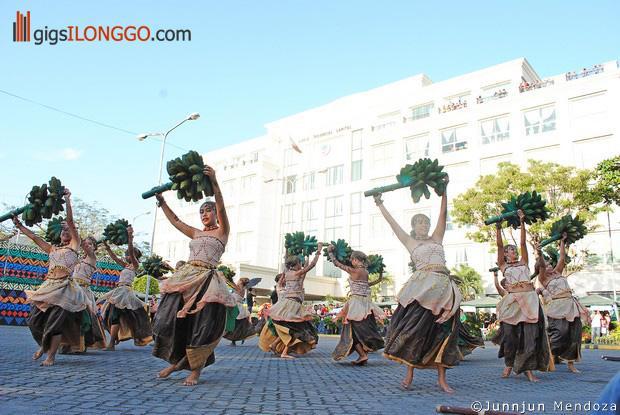
Passi is a rice and sugar-rich area and the only component city and the largest in the Province of Iloilo in terms of land area, population and income. It is popularly called the "Sweet City" of Panay due to its vast pineapple plantations and annual output in fruit production.

The people are endorsing the Ilonggo culture by the revitalization of traditional music, arts and dances. Pintados de Pasi festival is probably one of the finest, known and recognized festivals of the regions of Visayas that was well-developed over the years.

Some festivals in the province of Iloilo have either come back from near extinction or have evolved. And because of this, efforts have been undertaken by the community to breathe life into these cultural presentations that form part of a larger program of the tourism initiatives of the province to fully claim the title as the festival capital of the region, and to promote Ilonggo culture through the revival and preservation of traditional music and dances.

The Pintados de Pasi Festival, in Passi City, central of Iloilo province, is perhaps one of the best known and established festivals of the Visayan region that have evolved through the years. It has played a big part in the lives of most Passinhons. It is the most popular spectator cultural event and the most popular for the community that has a large following. Theatrical-like street dancing performances are a celebrated part of the Pintados festivity that is characterized by heavy and aggressive body movements. Here, performers adorned in traditional body tattoo with elaborate geometrical designs in their body, including their arms, legs and torso dramatizes stories in which the towns’ ancestral beings laid down every feature of the area, especially, their way of life.

Characterized by heavy and aggressive body movements, the dances seem to have developed independent of any external influences, as in the combat dances, folk plays, ritual actions, or character types. Historical or cultural sources are essential materials in sustaining a festival such as theirs. The festivity changed over the years, though its cultural presentation remained popular up to this day, and has resurrected and form part in a celebration that reflected function and transition. It also represented a major change in style and subject matter.
ImageTourism, through this cultural celebration brings thousands of local and international visitors interested to know the city’s rich history, considerable scenic beauty, and a number tourism attraction. The Passinhon 2000 Incorporated devotes their efforts of promoting the festival in the local and national scene. These efforts focus on the cultural festivity—at least in the early promotional stage, is the best way to keep it alive, and a variety of innovative efforts are underway to do just that. This year, 2008 marks the 10th Foundation Anniversary.
Body painting as well as carabao(water buffalo) painting contests are being practiced followed by a beauty pageant, a boat and bicycle racing events, and a tribal dancing competition.
Passi City celebrates the feast of its patron saint, San Guillermo (St. William) on the 10th of February along with the coronation of a fiesta queen.
History
It was the 1998 when the doors opened for a celebration of Pintados de Pasi festival, acknowledged being an original and spiritually appreciated art form tattooing was in countless cultures around world. Tattooing is a vital part of the Visayan culture. However other nations reflect that tattooing as a newly adopted art, Philippine history would tell us that in some parts of the Philippine country, precisely in the Visayas, the art of tattooing has been in manner for thousands of years. Early explanations of Visayan tattooing date back from 1590 and 1608 by Spanish explorers. It became a form of clothing. Certain designs recognized strength and personal accomplishments as well as desirability, fertility, and permanence of the family or village.
Date of the festival
The Pintados de Pasi is held during the third week of March, and the festival is celebrated annually at the beautiful and progressive town of Passi in the province of Iloilo. A week-long celebration of characterization traditional tattoo, the Pintados de Pasi festival is an important part in the lives of Passinhons or the people of Passi City. This festivity is one of the Philippines’ topmost tourism festivals.
Description
The Pintados or "painted" is a word applied to the people of the Visayan region throughout the Spanish colonization of the Philippines. The term was set to them since they painted their bodies with red clay or, as some authors say, on explanation of their being tattooed. Both men and women wear their hair long and fastened in a knot on the crown of the head. The men tattoo their whole bodies with same attractive figures, using some tiny pieces of iron dipped in ink. This ink combines itself with the blood, and the marks are permanent. At the Pintados de Pasi festivity, tattoed men, believed to have conquered the early days of Passi dance featuring supernatural traditions and beliefs. Stage-like street dancing presentations are a renowned portion of the Pintados de Pasi festivity that is categorized by full and aggressive body actions. In this feast, entertainers adorned in out-dated body tattoo with elegant geometrical symbols in their whole body, as well as their face, arms, legs and torso performs stories in which the cities’ inherited beings laid down each feature of the area, particularly, their way of their living.

Pintados de Pasi festival activities
- Tribal Dance competition
- Garden show
- Food festival
- Karosa parade
- Ginoo at Binibining Pintados pageant
- Dumog (Grappling tournament)
- Exhibit of exotic pets
- Pansundayag (Parade)
- Fireworks display
- Carabao-painting contest










